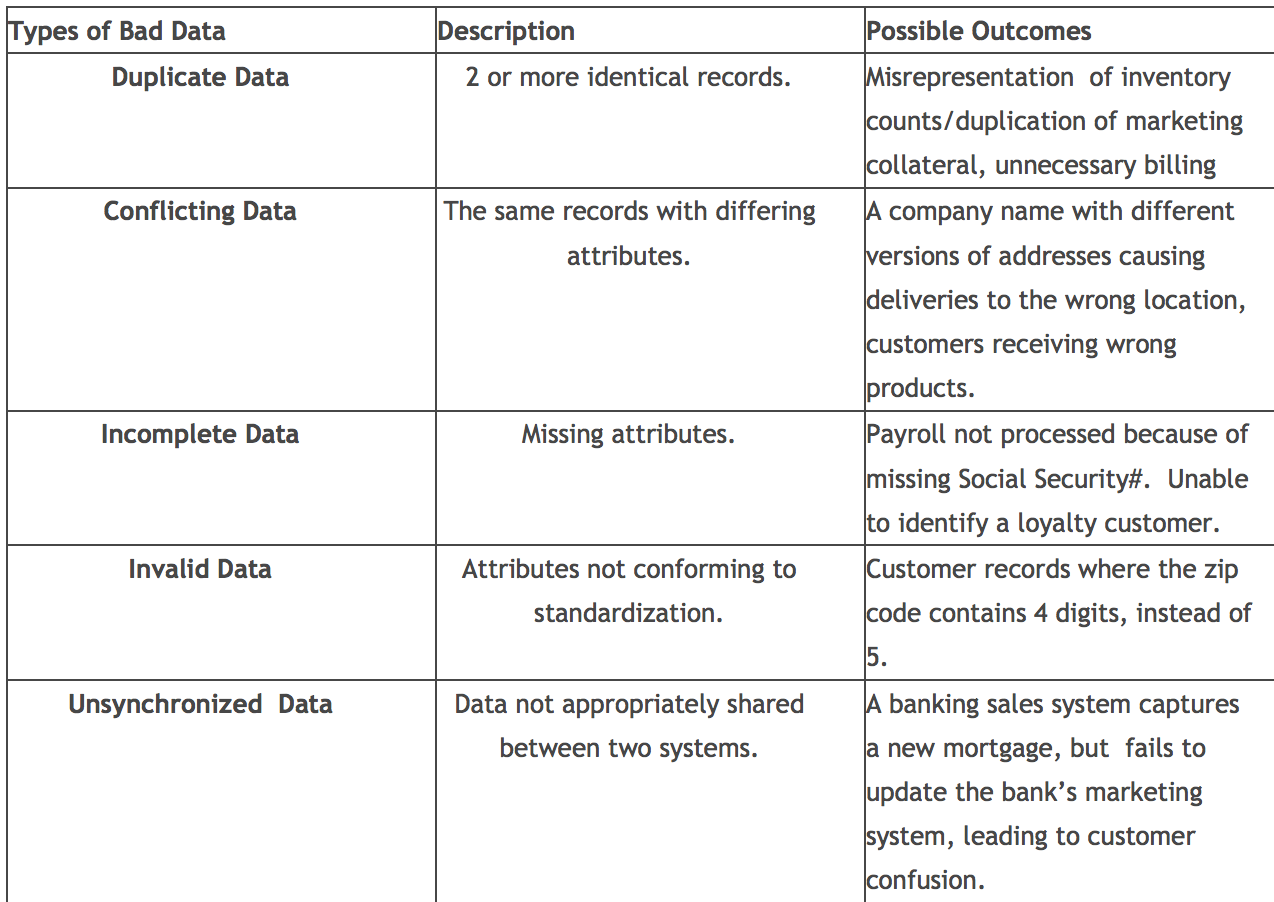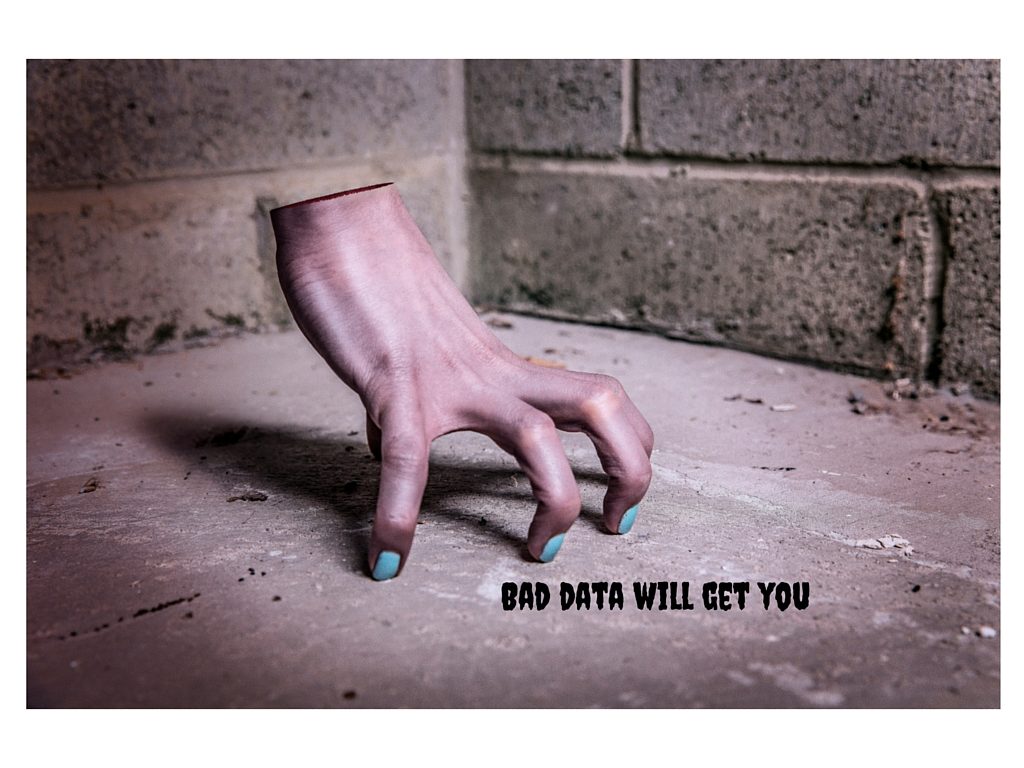It’s Halloween, a glorious day where people dress up in costumes, children get candy, and adults watch parents pretend that they ate all their children’s candy on Jimmy Kimmel the next day. It’s also a day for all things scary – witches, goblins, ghosts – but if you think ghosts are scary we’re here to remind you that they’re nothing in comparison to the errors in your data!
What is Bad Data? It can be duplicates, conflicting data, incomplete data, invalid data, or unsychronized data – all equally damaging to your company. The chart below demonstrates what each is and some of the horrific possible outcomes!

Bad data costs businesses money, time, and customers. Not only is it a huge hassle to recover and fix mistakes, but it reflects poorly on your business as bad customer service in the process. Here are 5 statistics to prove just how much damage bad data does and what you can do about it:
1. Bad Data costs the US economy over $3 Trillion a Year
Bad data costs the U.S. economy 3 TRILLION dollars a year. That means that bad data is responsible for a monetary loss that amounts to over twice the amount of the 2011 Federal Deficit.
2. The Business Cost of Bad Data may be as high as 10-25% of a Business’ revenue
Just in case you were having a hard time applying the first statistic to yourself, wrap your head around this one – bad data could potentially be costing you as much as 10-25% of your entire revenue! If your data was correct, you would have more money to put back into the business and grow your revenue even further.
3. The Cost to Fix a Single Error Can Be Over $100
The SiriusDecisions 1-10-100 Rule by W. Edwards Deming goes as follows: “It costs about $1 to verify a record as it is entered, about $10 dollars to fix it later, and $100 if nothing is done, as the ramifications of the mistakes are felt over and over again.”
The rule was relayed to Venture capitalist Tomasz Tunguz by an unnamed entrepreneur and made him realize the impact of a simple error. Tunguz said:
“If I’m lazy and don’t correct the error, later on that day one of my colleagues might search our CRM for the company and comes across the erroneous record which he suspects is inaccurate. First, he will check his notes, then he will call me to verify and then he will change the record. The rigamarole has undermined his trust of my data and the ten minutes he spent correcting my data entry are wasted.”
“Worst of all is if I contact a startup to inquire about an upcoming fund raise with incorrect data. As a result, I could miss an opportunity to partner with a great company because of incorrect timing or lose credibility with the startup’s executive team. The cost to the firm could be in the tens of millions of dollars.”
4. Approximately 15-45% of Operating Expense is Wasted Due to Bad Data
Data experts, like Thomas Redman, Jack Olson and Larry English all agree that approximately 15-45% of operating expenses of almost all organizations are wasted due to data quality issues.
This is informed by statistics like these: the average company involved in direct mail wastes about $180,000 a year on direct mailings not getting to the intended person. This number doesn’t even include other inaccuracies such as sending mail to the wrong demographic or to current customers. IT departments are also affected with as much as 50% of their IT budget going toward “information scrap and rework” related to dealing with poor data quality (Larry English).
5. All Bad Data is the Result of Little or No Standardization
Ok, this isn’t exactly a statistic, but it is the root cause of most bad data. It’s pretty harrowing to consider how much money is being wasted due to small things like pesky duplicates and data missing certain attributes. The good news is that by applying the right data integration technologies, you can immediately lower the number of data errors especially those that result from duplicate data entry across multiple applications and systems in your company.
There are, however, two caveats:
An integration product can’t just fix your bad data by itself – it’s important that you take the time to design the right data validation rules and checks for duplicates before moving data between systems using these technologies. Without this, you’ll end up creating data duplicates a lot faster than when you were doing manual data entry.
Second, not just any integration product will work. There are popular but simplistic integration products that simply do not have the capability to implement the logic for valid or duplicate data. These products can do basic one-to-one integrations i.e. move data from one app to another regardless of the quality of that data or whether that data, say a customer record, already exists in the target app.
We’re happy to report that Workato is a powerful, do-it-yourself cloud integration product that lets you create robust and secure data integrations (we call them ‘Recipes’) that move your data in real time, eliminate duplicate data and do complex data mapping.
For more information on how Workato can end bad data for your business you can Schedule a Demo with Workato and implement your first recipe in minutes!
